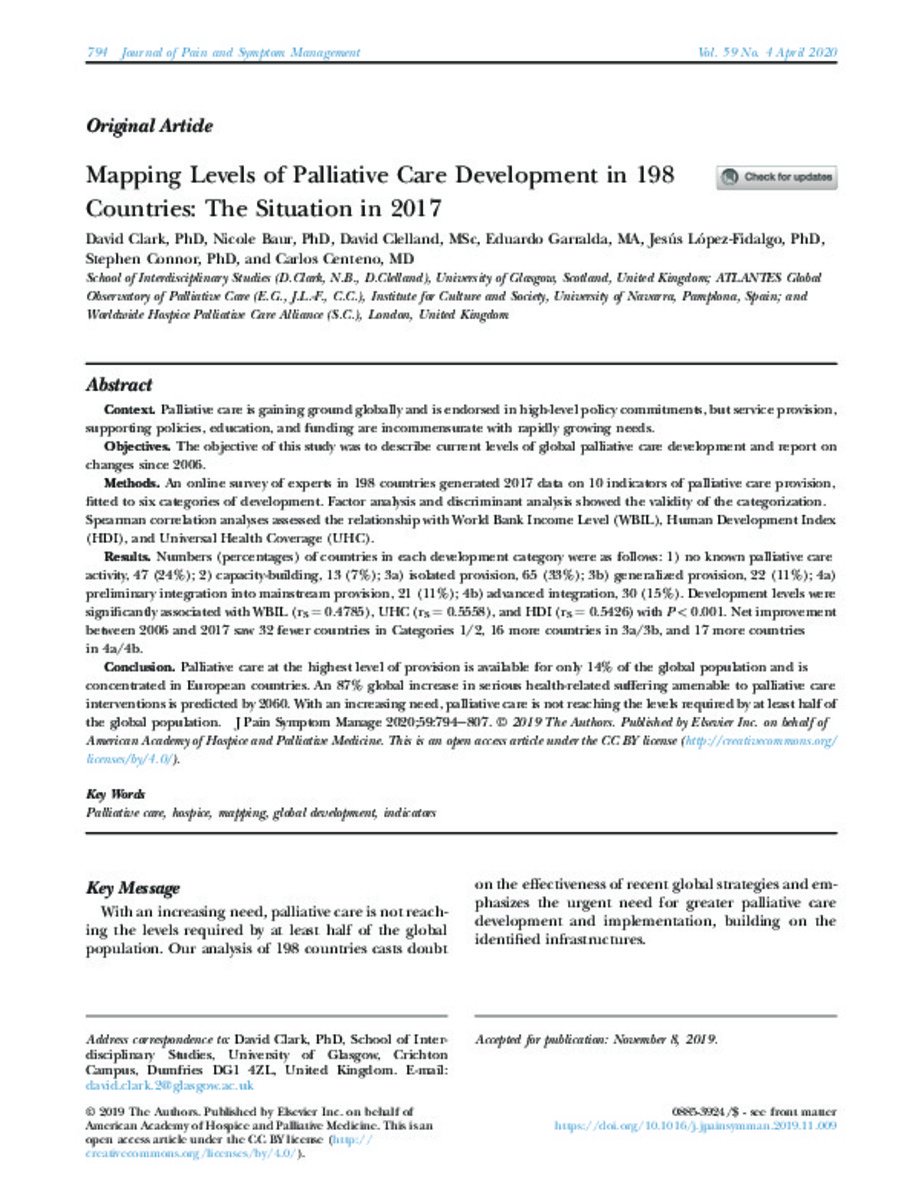Full metadata record
| DC Field | Value | Language |
|---|---|---|
| dc.creator | Clark, D. (David) | - |
| dc.creator | Baur, N. (Nicole) | - |
| dc.creator | Clelland, D. (David) | - |
| dc.creator | Garralda, E. (Eduardo) | - |
| dc.creator | López-Fidalgo, J. (Jesús) | - |
| dc.creator | Connor, S. (Stephen) | - |
| dc.creator | Centeno, C. (Carlos) | - |
| dc.date.accessioned | 2020-07-30T12:56:18Z | - |
| dc.date.available | 2020-07-30T12:56:18Z | - |
| dc.date.issued | 2020 | - |
| dc.identifier.citation | Clark, D., Baur, N., Clelland, D., Garralda, E., López-Fidalgo, J., Connor, S., & Centeno, C. (2020). Mapping levels of Palliative Care development in 198 Countries: the situation in 2017. Journal of Pain and Symptom Management, 59(4), 794-807.e4 | es_ES |
| dc.identifier.issn | 0885-3924 | - |
| dc.identifier.uri | https://hdl.handle.net/10171/59137 | - |
| dc.description.abstract | Context Palliative care is gaining ground globally and is endorsed in high-level policy commitments, but service provision, supporting policies, education, and funding are incommensurate with rapidly growing needs. Objectives The objective of this study was to describe current levels of global palliative care development and report on changes since 2006. Methods An online survey of experts in 198 countries generated 2017 data on 10 indicators of palliative care provision, fitted to six categories of development. Factor analysis and discriminant analysis showed the validity of the categorization. Spearman correlation analyses assessed the relationship with World Bank Income Level (WBIL), Human Development Index (HDI), and Universal Health Coverage (UHC). Results Numbers (percentages) of countries in each development category were as follows: 1) no known palliative care activity, 47 (24%); 2) capacity-building, 13 (7%); 3a) isolated provision, 65 (33%); 3b) generalized provision, 22 (11%); 4a) preliminary integration into mainstream provision, 21 (11%); 4b) advanced integration, 30 (15%). Development levels were significantly associated with WBIL (rS = 0.4785), UHC (rS = 0.5558), and HDI (rS = 0.5426) with P < 0.001. Net improvement between 2006 and 2017 saw 32 fewer countries in Categories 1/2, 16 more countries in 3a/3b, and 17 more countries in 4a/4b. Conclusion Palliative care at the highest level of provision is available for only 14% of the global population and is concentrated in European countries. An 87% global increase in serious health-related suffering amenable to palliative care interventions is predicted by 2060. With an increasing need, palliative care is not reaching the levels required by at least half of the global population. | es_ES |
| dc.description.sponsorship | This work was supported by an Investigator Award to David Clark [grant number 103319] from the Wellcome Trust, London, United Kingdom. | es_ES |
| dc.language.iso | eng | es_ES |
| dc.publisher | Elsevier | es_ES |
| dc.rights | info:eu-repo/semantics/openAccess | es_ES |
| dc.subject | Palliative care | es_ES |
| dc.subject | Hospice | es_ES |
| dc.subject | Mapping | es_ES |
| dc.subject | Global development | es_ES |
| dc.subject | Indicators | es_ES |
| dc.title | Mapping levels of Palliative Care development in 198 Countries: the situation in 2017 | es_ES |
| dc.type | info:eu-repo/semantics/article | es_ES |
| dc.editorial.note | This is an open access article under the CC BY license (http://creativecommons.org/licenses/by/4.0/) | es_ES |
| dc.identifier.doi | https://doi.org/10.1016/j.jpainsymman.2019.11.009 | es_ES |
| dadun.citation.endingPage | 807 | es_ES |
| dadun.citation.number | 4 | es_ES |
| dadun.citation.publicationName | Journal of Pain and Symptom Management | es_ES |
| dadun.citation.startingPage | 794 | es_ES |
| dadun.citation.volume | 59 | es_ES |
Files in This Item:
Statistics and impact
Items in Dadun are protected by copyright, with all rights reserved, unless otherwise indicated.






